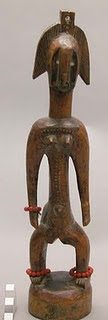As a Jo initiation figure, my work has assumed many different lives over the course of its history. It stood on its own as a figure before it was mounted on a staff. Once on that staff, it was only one of many different artifacts brought on a symbolic journey. Upon return, it was separated from its staff and became a self-standing object again. Then, it went from being a purely aesthetic, symbolic piece of decoration – meant for one initiate in particular – to being a functional toy for someone completely different. Most of this, of course, is speculation – until I know about the collection history of my particular piece, these details will be difficult to verify. But, as assumed from the lives of other known Jo initiation pieces, this makes the work flexible in function and meaning.
The life of the work began in the hands of a divinely inspired carver. For this carver, the work was a recipient of wisdom from the cosmos, as merely transferred through his own hands. The piece itself was a vessel of wisdom, and it alone was the concern of its maker.
The piece then became the object of social attention, as it is introduced to its intended initiate. It becomes almost a person, a representative of the ideal wife, a potential “girlfriend” for the initiate, and a means of playful teasing and banter. From a sacred object to a conversation piece – like a coffee-table book or a magazine – the transformation of the object’s life and meaning is an important one.
But then the self-defined object becomes part of something larger. It gets attached to a staff, and that staff gets carried with a number of other staffs. Has the severity of its significance been decreased? Or, has it at least suffered the consequences of distraction from other sources? Does it lose its own intrinsic value?
If the answer is yes, it is about to be even further exasperated, as the initiation comes to a close. The figure has done its job; it is now like an empty vessel, a shell, a mere souvenir of an event that once was. The initiate for whom it was intended has no claim over it; instead, it is given to young girls to play with, for no particular purpose, fertility or otherwise. A mere household object, a means of a child’s distraction; the holiness of the object has practically disappeared.
Not only has the work itself evolved in function and meaning, but interpretations of the work have evolved, as well. As Kate Ezra pointed out in the article cited below, figures like this were once considered to be fertility dolls, until that theory was clearly disproved. Later, it was considered to be a depiction of a deceased family member; only later was this interpretation found to be pure speculation. Just as the meaning of the piece itself changed over time, historian’s interpretation of both function and meaning are equally fluid.
To me, this all emphasizes the overly simplistic nature of inarguable definitions and distinctions. Just like our minds, an object’s significance is fluid, as are the interpretations of it. To slap a categorization or a definition onto a piece of artwork with a much more nuanced meaning is neglectful of the true intent and real life of that piece of artwork.







